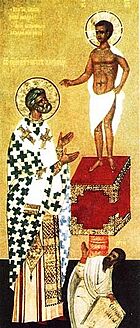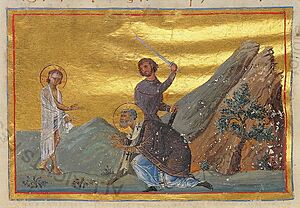Peter I of Alexandria facts for kids
Quick facts for kids Pope Peter of Alexandria |
|
|---|---|
| Seal of the Martyrs | |

Vision of Peter of Alexandria (Russian icon)
|
|
| Church | Church of Alexandria |
| Archdiocese | Alexandria |
| See | Alexandria |
| Predecessor | Theonas of Alexandria |
| Successor | Achillas of Alexandira |
| Personal details | |
| Born | 3rd century Alexandria, Egypt |
| Died | 25 November 311 Alexandria, Egypt |
| Sainthood | |
| Feast day |
|
| Venerated in | Catholic Church Eastern Orthodox Church Oriental Orthodoxy (Coptic Orthodox Church) |
| Title as Saint | Hieromartyr, “the Seal of the Martyrs“ |
| Attributes | Vested as a bishop, holding a Gospel Book |
Pope Peter I of Alexandria was an important leader in the early Christian Church. He was the 17th Patriarch of Alexandria, which is a very high position, like a main bishop, in the city of Alexandria, Egypt. People remember him as a saint in the Coptic Orthodox Church, the Eastern Orthodox Church, and the Catholic Church. He is sometimes called "the Seal of the Martyrs" because he was one of the last important Christian leaders to die for his faith during a time of great persecution.
Contents
Peter's Early Life and Role
Peter was born and grew up in Alexandria, an ancient city in Egypt. The Coptic Orthodox Church teaches that his parents gave him to Theonas, the leader of the church at that time. This was so Peter could be raised to become a priest, similar to the story of Samuel in the Old Testament.
Peter moved up through the different levels of church service. He started as a reader, someone who reads from the Bible in church. Then he became a deacon, who helps the priest. Finally, he became a priest. Peter was also very smart and well-educated. He became the head of the famous Catechetical School of Alexandria, which was a very important learning center for Christians.
Becoming a Church Leader
In the early 300s, when Pope Theonas was very old and close to death, he suggested that Peter should be the next leader. The church leaders agreed and chose Peter to be the new Pope and Patriarch.
Peter's time as a church leader was very difficult. It included the Diocletianic Persecution, which started in 303 AD. This was a time when the Roman Empire tried to stop Christianity by punishing Christians. The persecution lasted for about ten years, though it wasn't always happening everywhere at once.
Leading During Persecution
During these hard times, Peter was forced to leave Alexandria for a while. He traveled to different places, sending letters to his followers to encourage them. He wanted them to stay strong in their faith. Eventually, he returned to Alexandria to guide the church in person.
Peter secretly visited Christians who were in prison. He also helped widows (women whose husbands had died) and orphans (children who had lost their parents). He held church services in secret to avoid being caught by the Roman authorities.
There are different stories about what happened to Peter during the persecution. One story says he was put in prison with another bishop named Meletius of Lycopolis. While they were in prison, they had a big argument. They disagreed about how to treat Christians who had given up their faith. Some Christians had offered sacrifices to pagan gods or given their holy books to the authorities to save their lives.
Peter believed these Christians should be forgiven and allowed back into the church after showing they were truly sorry. Meletius, however, thought they had completely abandoned their faith and needed to be re-baptized. Their argument became very heated. Peter even hung a curtain between them to stop the fight.
One of Meletius's followers was a priest named Arius. Some historians believe this was the same Arius who later started a big debate about Jesus's nature. According to an ancient writer named Severus of Ashmumeen, Arius tried to get forgiveness from Peter before Peter was executed. But Peter refused and declared Arius a heretic, meaning someone who teaches false beliefs, and removed him from the church.

Peter's Martyrdom
The historian Severus of Ashmumeen wrote about how Peter became a martyr. During the persecution, Peter was arrested and put in prison. When the Roman emperor found out, he ordered Peter to be beheaded.
However, a large group of Christians gathered outside the prison. They were ready to die to protect their leader. The soldiers didn't want to hurt the crowd or start a riot.
Peter, worried about his people, came up with a plan. He told the soldiers to break a hole in a specific wall of the prison. This way, he could be secretly taken out and receive his sentence without causing a big fight with the crowd.
Severus of Ashmumeen describes Peter's final moments:
And he took off his omophorion, and bared his neck, which was pure before the Lord, and said to them: «Do as you have been commanded». But the soldiers feared that trouble would befall them because of him. So they looked one at another, and not one of them dared to cut off his head, because of the dread which had fallen upon them. Then they took counsel together and said: «To him that cuts off his head each one of us will give five denarii». Now they were six persons; and one of them had some money; so he took out five and twenty denarii from among the coins and said : «He that will go up to him, and cut off his head, shall receive this money from me and from the four others». So one of the men went forward, and summoned up his courage, and cut off the head of the holy martyr and patriarch Peter; that day being the 29th of Hatur.
Peter took off his omophorion, which is a special scarf worn by bishops. He bravely offered his neck to the soldiers. The soldiers were scared and didn't want to be the one to kill him. So, they decided to pay one of their own to do it. One soldier finally stepped forward and cut off Peter's head. This happened on the 29th day of Hatur, a month in the Coptic calendar. This day is roughly in November. Saint Peter died as a martyr in the year 311 AD.
Feast Day
In Christianity, a saint's feast day is usually celebrated on the day they died. For Saint Peter, the 29th of Hatur is his feast day in the Coptic Church. This day usually matches November 25th in the old Julian calendar. In our modern Gregorian calendar, it would be around December 8th or 9th.
See also
- Baucalis

